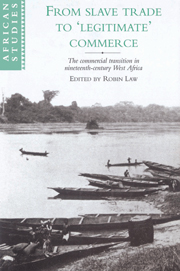 From Slave Trade to 'Legitimate' Commerce
From Slave Trade to 'Legitimate' Commerce Published online by Cambridge University Press: 21 September 2009
The idea that parts of West Africa experienced a ‘crisis of adaptation’ in the nineteenth century with the transition from the slave trade to what was termed at the time ‘lawful commerce’, has been one of the most debated issues in West African historiography. This concept goes back a long way but in recent years it has been the writings of A. G. Hopkins that have most fully spelt out what it entailed. For Hopkins, the transition from slave-trading to produce-trading had serious political consequences for parts of West Africa, which culminated in a ‘crisis of adaptation’ which in turn led on to British imperial intervention. As is well known, however, not all historians of the area have been convinced by Hopkins' analysis. Austen, indeed, describes the transition as ‘adaptation without revolution’, and many writers have questioned whether it amounted to a ‘crisis’ in any meaningful sense. The ensuing debate has been a compelling one for historians of the region, with numerous case studies being produced to show the validity of one side or other. However, as Law has implied in his recent survey of writings on this topic, something of a consensus might now be said to have developed. Few historians, he suggests, now argue for a ‘crisis of adaptation’ in the coastal trading states of West Africa in the nineteenth century.
To save this book to your Kindle, first ensure [email protected] is added to your Approved Personal Document E-mail List under your Personal Document Settings on the Manage Your Content and Devices page of your Amazon account. Then enter the ‘name’ part of your Kindle email address below. Find out more about saving to your Kindle.
Note you can select to save to either the @free.kindle.com or @kindle.com variations. ‘@free.kindle.com’ emails are free but can only be saved to your device when it is connected to wi-fi. ‘@kindle.com’ emails can be delivered even when you are not connected to wi-fi, but note that service fees apply.
Find out more about the Kindle Personal Document Service.
To save content items to your account, please confirm that you agree to abide by our usage policies. If this is the first time you use this feature, you will be asked to authorise Cambridge Core to connect with your account. Find out more about saving content to Dropbox.
To save content items to your account, please confirm that you agree to abide by our usage policies. If this is the first time you use this feature, you will be asked to authorise Cambridge Core to connect with your account. Find out more about saving content to Google Drive.